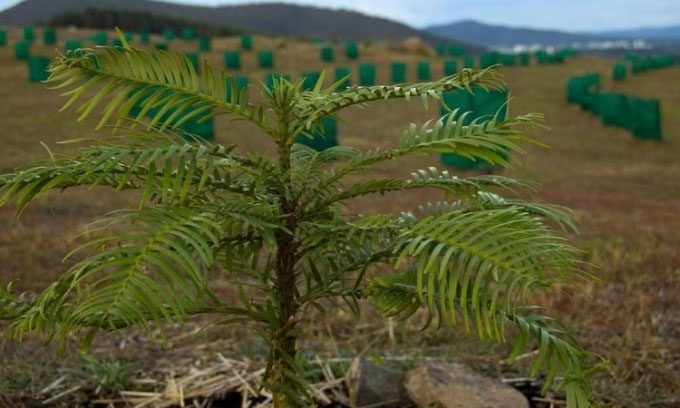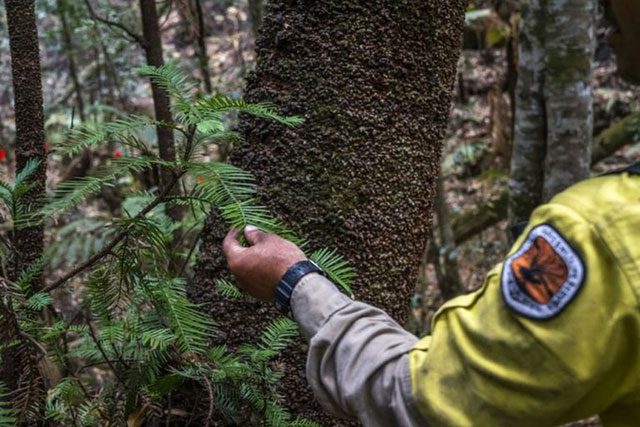A team of scientists is working to reintroduce the Wollemi pine, which went extinct 2 million years ago, back into the wild.
Researchers are cultivating “living fossils” at a secret location to save this lost species from the brink of extinction in efforts that could last for decades. The Wollemi pine (Wollemia nobilis) is believed to have disappeared 2 million years ago. Fossils of this species from the Cretaceous period (66 – 145 million years ago) indicate that they have changed little in appearance over time.

The Wollemi pine has remained unchanged for 66 million years. (Photo: ABC News).
In 1994, a climber in the Blue Mountains of Australia encountered a surviving specimen of this ancient pine species. Today, only about 60 trees exist in Wollemi National Park. They are threatened by Phytophthora cinnamomi, a pathogenic fungus, and ongoing wildfires in New South Wales. Since its rediscovery, the Wollemi pine has been cultivated in botanical gardens and private lands around the world. The Wollemi Pine Recovery Team, a collaborative project between the Australian government and conservation scientists, has begun the process of reintroducing young saplings at three locations within Wollemi National Park.
The Wollemi belongs to the Araucariaceae family and is naturally found only in Australia. The Wollemi pine typically reaches heights of about 25-40 meters. Its trunk has a dark brown bark. This species is distinguished from other pines by its branches that grow around a single trunk and only reach a certain size.
After a few years, a flower appears at the end of each branch and then growth ceases. Once the flower produces seeds, the branch dries up and falls off. The seeds will sprout into new pine trees, while new branches will grow from the mother tree.
This species of pine has a very long lifespan. Some current trees are estimated to be 500-1,000 years old.
After decades of propagation, this species can now be found in several countries, but only 200 Wollemi pines are believed to exist naturally at a secret location within the 5,000 km2 Wollemi National Park, northwest of Sydney, which is thought to be the oldest.
According to researchers, the rarity of this tree species is due to a lack of genetic diversity, although its gene analysis shows it has 12.2 billion base pairs of chromosomes, a number four times higher than that of humans.
However, the difficulty of reproduction lies in the large number of transposons, segments of DNA capable of moving through the genome. The fewer stable transposons, the less developed the organism becomes.

The Wollemi pine is classified as critically endangered (CR) and is specially protected by the Australian government.
According to a representative of the team, the selected locations include sandstone gorges at high altitudes, which are deep, narrow, and steep enough to provide shelter for the trees from intense wildfires and drought. Researchers also found no evidence of Phytophthora infection at the site when surveying just before transporting the young saplings, and the likelihood of outside visitors is very low due to the remote location.
After an experimental planting effort in 2012, the recovery team launched a wider project in 2019. More than 400 young saplings were planted at two locations. Due to drought, the team had to transport thousands of liters of water to help the trees survive. By the end of that year, a significant number of trees were destroyed by wildfires. Only 58 saplings remained in 2023.
In 2021, another 502 Wollemi pines were planted at the sites to replace those lost in the fires. Thanks to favorable conditions from the La Niña phenomenon, the number of surviving trees exceeded expectations. However, landslides from heavy rain in 2022 caused some trees to die. The recovery team has implemented several measures to prevent Phytophthora infection. The planting locations are kept secret, and the recovery team also limits their time near the trees. They continuously sterilize their shoes to prevent the possibility of carrying root rot fungal spores.
While the new population of trees is being closely monitored, the fate of the Wollemi pine in the wild remains uncertain. Young trees grow less than one centimeter a year, meaning they need decades to mature and produce seeds. Some trees can produce seedlings growing from the mother tree, but it is unclear when they will be able to develop independently. Wildfires and various climate-related issues, such as reduced rainfall, are likely to impact recovery efforts in the coming years.


















































